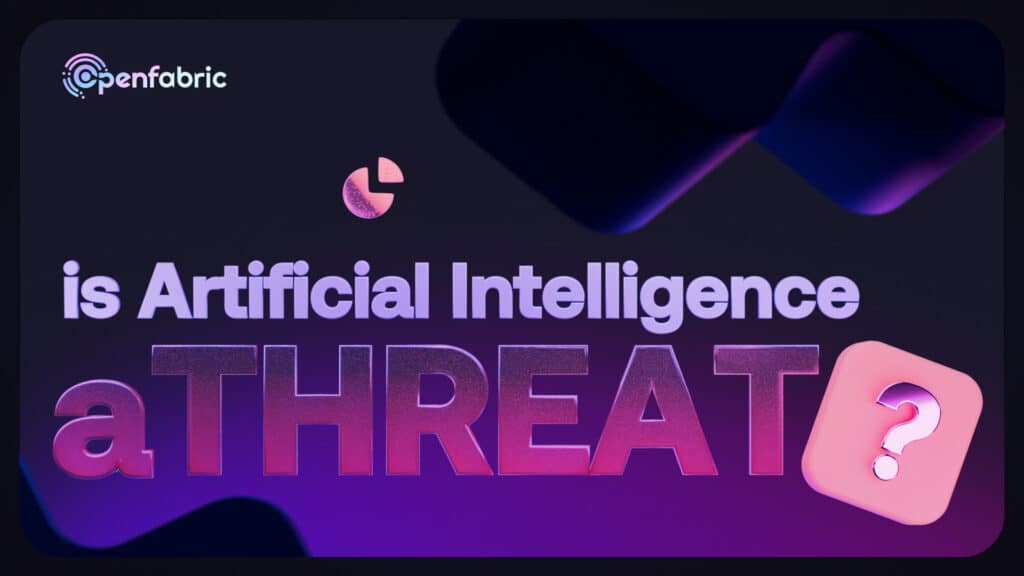
May 13, 2024 11 minutes read
Is Artificial Intelligence a Threat to Job and Employment?

As the already established next stop of technological progress, AI stands as the next crescendo, promising to redefine our world. Yet, amidst the whispers of grapevine talks, fear takes root; the fear of job scarcity, of humans being overshadowed by algorithms. But let’s set the record straight. AI isn’t the harbinger of unemployment; it’s the harbinger of opportunity. These points here will buttress why:
- AI Augmentation, Not Replacement
- New Job Opportunities
- Increased Productivity and Economic Growth
- Skill Enhancement and Reskilling Programs
- Human-Machine Collaboration
- Addressing Socioeconomic Inequalities
- Adaptation and Evolution
- Case Studies and Success Stories
- Collaborative Approach
AI Augmentation, Not Replacement
AI technology wields the potential to enhance human capabilities rather than render them obsolete. In the discourse surrounding job security and the future of employment, it is crucial to understand that AI serves as a tool, not a replacement, amplifying productivity, efficiency, and creativity across various industries.
In sectors ranging from manufacturing to healthcare, AI augments human efforts by streamlining processes and enabling more informed decision-making. For instance, in manufacturing plants, AI-powered robots work alongside human workers to automate repetitive tasks, allowing employees to focus on more complex assignments that require human ingenuity. This collaboration between humans and AI fosters a symbiotic relationship, where each party complements the strengths of the other.
Moreover, AI algorithms analyze vast datasets at speeds beyond human capacity, providing valuable insights that empower professionals to make data-driven decisions. In healthcare, AI-powered diagnostic tools assist physicians in accurately identifying ailments and determining the most effective treatment plans. By swiftly analyzing medical images and patient data, AI reduces diagnostic errors and enhances the quality of care, ultimately saving lives.
Additionally, AI technology facilitates innovation by serving as a catalyst for creativity. In the entertainment industry, AI algorithms analyze audience preferences to generate personalized content, ranging from music playlists to movie recommendations. By understanding consumer behavior on a granular level, AI empowers content creators to tailor their offerings to meet evolving demands, fostering deeper engagement and loyalty among audiences.
Automation of Routine tasks
Critics often express concerns about the potential job displacement caused by AI technology. However, historical precedent suggests that technological advancements have consistently led to the creation of new job opportunities. As AI automates routine tasks, it frees up human workers to focus on higher-value activities that require emotional intelligence, critical thinking, and problem-solving skills. Qualities that are inherently human and cannot be replicated by machines.
Furthermore, the widespread adoption of AI technology spurs job creation in related fields, such as data analysis, software development, and AI system maintenance. As organizations invest in AI infrastructure, they require skilled professionals to manage and optimize these systems, driving demand for specialized talent. Additionally, the emergence of AI startups and innovation hubs creates fertile ground for entrepreneurship, offering individuals the opportunity to pioneer groundbreaking solutions and carve out new niches in the digital world.
New Job Opportunities
The implementation of AI brings forth a wave of new job opportunities across various industries. As companies integrate AI technology into their operations, the demand for skilled professionals in roles related to AI development, maintenance, data analysis, and more continues to rise.
In AI development, companies seek talented individuals to design and create AI algorithms and systems. These professionals play a crucial role in pushing the boundaries of AI technology, exploring new possibilities, and solving complex problems. With the constant evolution of AI, there is a growing need for developers who can adapt to changing trends and innovate within the field.
Maintenance of AI systems is another area that offers promising career prospects. As organizations rely on AI to streamline processes and improve efficiency, they require specialists to ensure the smooth functioning of these systems. From troubleshooting technical issues to implementing updates and optimizations, maintenance professionals play a vital role in maximizing the performance and reliability of AI infrastructure.
Data analysis is integral to the success of AI initiatives, driving informed decision-making and strategy development. As businesses collect and analyze vast amounts of data, the demand for skilled data analysts continues to soar. These professionals possess the expertise to extract actionable insights from data, helping organizations gain a competitive edge and drive innovation.
So, while AI may disrupt traditional job roles, it also brings forth a plethora of new opportunities for skilled professionals. By embracing the potential of AI technology and investing in relevant skills and expertise, individuals can navigate the changing landscape of employment and thrive in the digital economy. As industries continue to harness the power of AI to drive innovation and growth, the future of work holds promise for those who are prepared to adapt and seize the opportunities presented by this transformative technology.
Openfabric’s Role
You may ask: “Where is Openfabric in all of these?” Your question isn’t out of place and we have your answer. In a bid to continue to be the bridge between our everyday life and Artificial Intelligence, job creation through AI has been in the frontlines of what Openfabric has in plans.
Openfabric’s AI app store is a bustling hub of opportunity, offering a variety of apps that not only entertain but also create job prospects for individuals. Through platforms like Memefabric and Soundfabric bot, users can explore their creativity, generating memes and music effortlessly. This accessibility opens doors for content creators to monetize their skills.
Developers, too, find ample opportunities within Openfabric’s ecosystem. They can craft innovative apps tailored to specific needs, further enriching the store’s offerings and expanding its reach. This process not only fosters economic growth but also cultivates a vibrant community of developers.
In essence, Openfabric acts as a catalyst for job creation, leveraging AI technology to empower individuals. Rather than displacing workers, it amplifies their capabilities, providing a protocol where talent flourishes. As the store continues to evolve, so too do the opportunities it presents, ensuring that the future workforce remains dynamic and adaptable. Through collaboration and innovation, Openfabric demonstrates the transformative potential of AI in fostering employment and driving progress.
Increased Productivity and Economic Growth
AI-driven automation changes industries by streamlining processes, leading to increased productivity and economic growth. As businesses integrate AI technologies into their operations, they optimize efficiency, reduce costs, and accelerate production cycles. This enhanced productivity creates a ripple effect throughout the economy, generating job opportunities across different sectors.
Furthermore, AI technology facilitates the development of new products and services, spurring innovation and entrepreneurship. Startups and established companies alike leverage AI to develop cutting-edge solutions that address unmet needs and revolutionize industries. This culture of innovation fosters economic dynamism, attracting investment, talent, and resources to fuel growth and expansion.
After all said, AI-driven automation holds the promise of increased productivity and economic growth, driving job creation and innovation across various sectors. Businesses can use the power of AI technology to optimize processes, leverage data insights, and foster collaboration. This will unlock new opportunities for growth and prosperity. As we navigate the evolving landscape of employment, embracing the transformative potential of AI is essential. Reason being to build a more resilient, dynamic, and inclusive economy for the future.
Skill Enhancement and Reskilling Programs
Investing in education and training programs is necessary. This is in order to equip individuals with the skills needed to thrive in an AI-driven economy. Governments, educational institutions, and businesses recognize the importance of providing such programs to ensure that workers are prepared for the jobs of the future.
Governments play a crucial role in supporting skill enhancement and reskilling initiatives through policies and funding. Many countries have implemented programs to promote lifelong learning and provide access to affordable education and training opportunities. By investing in workforce development, governments aim to empower individuals to adapt to technological advancements and remain competitive in the labor market.
Educational institutions also play an important role in preparing individuals for the challenges and opportunities presented by AI technology. Universities, colleges, and vocational schools offer courses and programs tailored to the needs of a rapidly changing economy. Educational institutions strive to equip students with knowledge in computer science and data analytics, even soft skills like communication and problem-solving. This enhances competencies required to succeed in an AI-driven world.
Furthermore, businesses recognize the importance of investing in their workforce to ensure continued success and innovation. Many companies offer training programs and professional development opportunities. This helps employees acquire new skills and stay abreast of emerging technologies. By investing in the skill development of their workforce, businesses enhance productivity and efficiency. It has alson been proven that it fosters a culture of continuous learning and growth.
Human-Machine Collaboration
AI facilitates collaboration between humans and machines, resulting in more efficient workflows and problem-solving. By harnessing the capabilities of AI technology, workers can streamline processes and achieve better outcomes.
In various industries, AI serves as a valuable tool that complements human expertise. For example, in manufacturing, AI-powered robots work alongside human workers to automate repetitive tasks, such as assembly or packaging. This collaboration allows workers to focus on more complex tasks that require human ingenuity and problem-solving skills.
Moreover, AI algorithms analyze vast amounts of data with speed and accuracy, providing valuable insights that inform decision-making. In sectors such as healthcare, AI-powered diagnostic tools assist physicians in accurately identifying ailments and determining the most effective treatment plans. By analyzing medical images and patient data, AI reduces diagnostic errors and enhances the quality of care.
Furthermore, AI technology enhances creativity and innovation by providing new tools and resources for problem-solving. In the field of design, for instance, AI-powered software can generate ideas and prototypes based on input from human designers. This collaboration between human creativity and AI algorithms leads to the development of innovative solutions that meet the needs of users.
Overall, AI enables humans to focus on tasks that require empathy, creativity, and critical thinking, while automating routine and repetitive tasks. This human-machine collaboration leads to more efficient workflows and better outcomes across various industries. As AI technology continues to evolve, it will increasingly complement human expertise, driving innovation and growth in the workforce.
Adaptation and Evolution
Encouraging a change of mindset from fear of displacement to adaptation and evolution is necessary in the discourse surrounding the impact of AI on job security and the future of employment. Just as previous technological advancements have sparked concerns about job loss, they have also created new industries and job opportunities. Similarly, AI presents similar opportunities for innovation and growth.
Rather than viewing AI as a threat to job security, individuals and organizations should embrace it as a catalyst for adaptation and evolution. By recognizing the potential of AI to augment human capabilities and improve productivity, we can harness its transformative power to create new possibilities for employment and economic prosperity.
Historically, technology has led to the displacement of jobs but have also paved the way for the new occupations. For example, the rise of the internet and e-commerce disrupted traditional retail models but gave birth to new opportunities in online commerce, digital marketing, and logistics. Similarly, AI has the potential to transform industries ranging from healthcare and finance to transportation and manufacturing, creating demand for skilled professionals in AI development, data analysis, and related fields.
Case Studies and Success Stories
Real-world examples of organizations and industries integrating AI technologies while enhancing job security and creating new employment opportunities showcase the potential for positive outcomes.
In the healthcare sector, AI-powered diagnostic tools have improved patient care and increased job satisfaction among healthcare professionals. Example, the Mayo Clinic implemented AI algorithms to analyze medical images and identify signs of disease more accurately and efficiently. As a result, physicians can make more informed decisions and provide better treatment options. This leads to improved health outcomes for patients. Rather than replacing healthcare professionals, AI technology complements their expertise. Allowing them to focus on delivering personalized care and building stronger relationships with patients.
Similarly, in the manufacturing industry, AI-driven automation has transformed production processes while creating new job roles. Tesla’s Gigafactory is a notable example of how AI-powered robots work alongside human workers to assemble electric vehicles. By automating repetitive tasks, such as welding and painting, AI technology has improved efficiency and reduced the risk of injuries for workers. Meanwhile, skilled technicians are needed to oversee and maintain the robots. This leads to the creation of new job opportunities in robotics engineering and maintenance.
Moreover, AI-powered customer service solutions have enhanced job satisfaction and efficiency in the service industry. Companies like Amazon have implemented AI-driven chatbots to handle customer inquiries and support requests. These chatbots can quickly respond to common questions and resolve issues, freeing up human agents to focus on more complex queries that require empathy and problem-solving skills.
Overall, these case studies illustrate how AI technologies can be integrated into various industries to enhance job security and create new employment opportunities. Organizations can embrace AI as a tool for augmentation rather than replacement. This will unlock the full potential of their workforce and drive innovation and growth in the digital age.
Collaborative Approach
Advocating for a collaborative approach among policymakers, businesses, educators, and individuals is crucial to harnessing the full potential of AI for the benefit of society. By working together, we can shape a future where AI complements human labor and fosters sustainable economic development.
Policymakers play a pivotal role in creating an enabling environment for the responsible deployment of AI technologies. They can establish regulations and guidelines that promote ethical AI development and deployment, ensuring that AI systems are transparent, accountable, and inclusive. Additionally, policymakers can invest in infrastructure and education initiatives to equip individuals and communities with the skills needed to thrive in an AI-driven economy.
Businesses have a vested interest in embracing AI technologies to drive innovation and growth. They can leverage AI to optimize processes, improve decision-making, and create new products and services that meet evolving consumer demands. By investing in AI research and development, businesses can stay competitive in the global marketplace and create new job opportunities for workers across various sectors.
Educators play a crucial role in preparing the workforce of the future for the challenges and opportunities presented by AI technology. They can incorporate AI-related topics into curricula and provide training programs that equip students with the skills and competencies needed to succeed in an AI-driven world. Additionally, educators can foster a culture of lifelong learning and adaptation, encouraging individuals to stay abreast of technological advancements and pursue continuous skill development.
Conclusively
Individuals also have a responsibility to adapt to the changing landscape of employment and embrace the opportunities presented by AI technology. By staying informed about AI trends and developments, individuals can position themselves for success in emerging job roles and industries. Moreover, individuals can advocate for policies and initiatives that promote equitable access to AI technologies and ensure that the benefits of AI are shared by all members of society.
A collaborative approach among policymakers, businesses, educators, and individuals is essential to realizing the full potential of AI for the benefit of society. By working together, we can shape a future where AI enhances human labor, fosters economic development, and creates opportunities for all.

